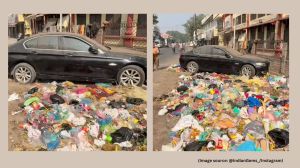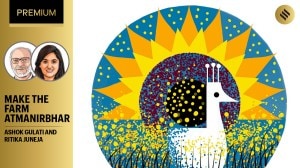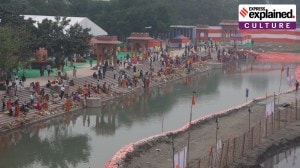N-talk? Tehran also loves spaghetti straps talk
With Mahmoud Ahmedinejad’s swearing in tomorrow as President, hardliners will control all three power centres in Iran’s theocracy....

With Mahmoud Ahmedinejad’s swearing in tomorrow as President, hardliners will control all three power centres in Iran’s theocracy. The Parliament (Majlis) lost most of its reformist MPs in last year’s elections and the Supreme Council, headed by Ayatollah Khamenei, has always been a bulwark of religious conservatism.
Western observers predict that Ahmedinejad’s assumption of office means a return to the puritanical cultural and social restrictions of the early days of the Revolution.
Adding to the sense of unease is the fact that Iran seems to be heading for a major showdown with the US, given its refusal to abandon its ongoing nuclear research programme, which it maintains is for peaceful purposes. Significantly Iran has decided to break UN seals on its Isfahan nuclear plant just as Ahmedinejad assumes office.
But doomsday forecasts for Iran ignore an important reality. The real challenge to Ahmedinejad’s government, if it tries to backtrack on the social and economic reforms of the last decade, will come not from moderate reformists, such as former Presidents Akbar Hasheimi Rafsanjani who was roundly defeated at the polls, but from the youth of Iran.
Iran’s population of 67 million is predominantly young with 60 per cent under 30 years. Most have no first hand experience of the excesses of the 1979 violent overthrow of the Shah’s regime and the religious fundamentalism of the early years of the Islamic Revolution.
It is over 16 years since the eight-year-long debilitating war with Iraq ended, in which thousands of young men lost their lives. Iranian youth in the cities are today familiar with satellite TV and internet, even if they are officially banned.
Young people here are not inward looking but have similar aspirations to their counterparts in other parts of the world. They are concerned about the country’s phenomenally high 10 per cent unemployment and the fact that although oil-producing Iran has the second largest gas reserves in the world, the benefits have not percolated to the people.
A visit to Iran in July—during the change-over period between the surprise poll results of June and Ahmedinejad’s formal take-over—shows very clearly that Iran’s newfound glasnost cannot be easily snatched away.
Maheema, a young woman from Tehran who flaunts bleached hair, loads of make and holds hands with her boyfriend remarked, ‘‘Some people have fears about the new regime, but I am sure the President will realise he must give people the right to choose what they want to wear and how to conduct themselves. There are bigger economic problems to worry about.’’
To the world one of the best known images of modern Iran is the rather grim-faced poster of the hero of the revolution, Ayatollah Khomeini. Which is why the current rather relaxed dress code and the chilled out atmosphere comes as an eye opener to outsiders.
Significantly, Iranians did not appear awed by the impending change of guard and seemed in no hurry to alter their lifestyle. Women in the more religious parts of the country may cover themselves in thick black chadars, but a number of the younger women in cities like Tehran and Shiraz are smartly turned out in figure hugging coats, wearing flimsy gauze scarves, sandals and pants.
The shops in Tehran are filled with mini skirts, Capri pants, sleeveless white lace wedding dresses, and tops with spaghetti straps indicating that within their houses Iranian women happily discard dress restrictions. In fact the group from the Indian Women Press Corps, with whom I travelled to Iran last month, looked distinctly dowdy in their long shapeless kurtas and heavy chunnis, covering their heads compared to the elegant Iranian women.
By the end of the trip, the dress code had unwound several notches in view of the high temperatures and the general ambience. A diplomat describes Iran as ‘‘an example of an Aryan mechanism for handling Islam’’. And Iranians make a point of stressing they are very different from their Arab neighbours.
Rather than view the world through extremes of black and white, Persians are a pragmatic people who prefer nuanced shades of grey. When a car with teenagers whizzes by with loud pop music blaring from the open window, an Iranian explains, ‘‘Pop music is forbidden but tolerated.’’ The law forbids men and women from sitting side by side in public buses but in the shared taxis, nobody protests at the sexes mingling.
The law still disallows a woman from taking major decisions without the consent of her husband and there are only a dozen women MPs in Parliament. Nevertheless, Iranian women enjoy a higher degree of emancipation than most of their sex in West Asia. Female literacy in Iran is 81 per cent. Sixty-four per cent of all university students are women, and there are more girls in school than boys. Women had a higher voter turnout in the elections than men.
Considering George Bush attempts to isolate Iran from the rest of the world, surprisingly the average Iranian expressed enormous goodwill towards the American people, though not for their leader.
The joke in Tehran is that Bush facilitated Ahemdinejad’s victory. With the US issuing a statement on poll-eve, lamenting the absence of what it called genuine democracy in Iran, there was a much higher than normal voter turn-out since the proud Iranians were keen to prove him wrong.
—(The writer was in Iran recently)



- 01
- 02
- 03
- 04
- 05




























